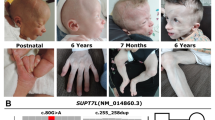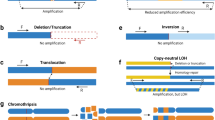Abstract
Pallister-Killian syndrome is a multisystem sporadic genetic diagnosis characterized by facial dysmorphia, variable developmental delay and intellectual impairment, hypotonia, seizures, diaphragmatic hernia, and other systemic abnormalities. Pallister-Killian syndrome is typically caused by the presence of a supernumerary isochromosome that is always present in a tissue limited mosaic pattern, resulting in tetrasomy 12p due to the two extra copies of 12p. We evaluated the potential contribution of microRNAs located on 12p to the pathogenesis of Pallister-Killian syndrome phenotype. Using skin fibroblast cell lines from 13 probands with Pallister-Killian syndrome and 5 normal matched controls, the expression level of 5 microRNAs located on 12p and their target gene mRNA levels were measured. All measured micro RNAs located on 12p were overexpressed in Pallister-Killian syndrome fibroblasts, although the fold difference of the expression level was lower than copy number differences. Among the five microRNAs, miR-1244 had the highest fold difference. Many of computer-predicted target genes of miR-1244 were downregulated in Pallister-Killian syndrome skin fibroblasts. In particular, expression levels of MEIS2 and UQCRB were significantly decreased in Pallister-Killian syndrome samples, and an inverse linear correlation was seen between the level of miR-1244 and MEIS2 and UQCRB expression levels. Since many of computer-predicted miR-1244 target genes play roles in transcriptional regulation, overexpression of miR-1244 due to tetrasomy 12p may contribute to the pleiotropic phenotype of Pallister-Killian syndrome by modulating its downstream target genes including MEIS2 and UQCRB.




Similar content being viewed by others
Abbreviations
- Pallister-Killian Syndrome:
-
PKS
- MicroRNAs:
-
miRNAs
- Untranslated region:
-
UTR
- Droplet digital PCR:
-
DDPCR
References
Ackerman KG, Herron BJ, Vargas SO et al (2005) Fog2 is required for normal diaphragm and lung development in mice and humans. PLoS Genet 1:58–65
Avnit-Sagi T, Kantorovich L, Kredo-Russo S, Hornstein E, Walker MD (2009) The promoter of the pri-miR-375 gene directs expression selectively to the endocrine pancreas. PLoS One 4(4):e5033
Benjamini Y, Hochberg Y (1995) Controlling the false discovery rate: a practical and powerful approach to multiple testing. J R Stat Soc Ser B 57:289–300
Crowley MA, Conlin LK, Zackai EH, Deardorff MA, Thiel BD, Spinner NB (2010) Further evidence for the possible role of MEIS2 in the development of cleft palate and cardiac septum. Am J Med Genet A 152A(5):1326–1327
de Pontual L, Yao E, Callier P et al (2011) Germline deletion of the miR-17 approximately 92 cluster causes skeletal and growth defects in humans. Nat Genet 43(10):1026–1030
Elton TS1, Sansom SE, Martin MM (2010) Trisomy-21 gene dosage over-expression of miRNAs results in the haploinsufficiency of specific target proteins. RNA Biol. 7:540–7
Foster JW, Dominguez-Steglich MA, Guioli S et al. (1994) Campomelic dysplasia and autosomal sex reversal caused by mutations in an SRY-related gene. Nature. 1994 Dec 8;372 (6506):525–30.
Fukao T, Fukuda Y, Kiga K et al (2007) An evolutionarily conserved mechanism for microRNA-223 expression revealed by microRNA gene profiling. Cell 129(3):617–631
Geiss GK, Bumgarner RE, Birditt B et al (2008) Direct multiplexed measurement of gene expression with color-coded probe pairs. Nat Biotechnol 26(3):317–325
Gregory PA, Bert AG, Paterson EL et al (2008) The miR-200 family and miR-205 regulate epithelial to mesenchymal transition by targeting ZEB1 and SIP1. Nat Cell Biol 10:593–601
Hausser J, Berninger P, Rodak C et al (2009) MirZ: an integrated microRNA expression atlas and target prediction resource. Nucleic Acids Res 37:W266–W272
Haut S, Brivet M, Touati G, Rustin P, Lebon S, Garcia-Cazorla A, Saudubray JM, Boutron A, Legrand A, Slama A (2003) A deletion in the human QP-C gene causes a complex III deficiency resulting in hypoglycaemia and lactic acidosis. Hum Genet 113(2):118–22
Huntzinger E, Izaurralde E (2011) Gene silencing by microRNAs: contributions of translational repression and mRNA decay. Nat Rev Genet 12(2):99–110
Hyun S, Lee JH, Jin H et al (2009) Conserved microRNA miR-8/miR-200 and its target USH/FOG2 control growth by regulating PI3K. Cell 139:1096–1108
Izumi K, Conlin LK, Berrodin D et al (2012) Duplication 12p and Pallister-Killian syndrome: a case report and review of the literature toward defining a Pallister-Killian syndrome minimal critical region. Am J Med Genet A 158A(12):3033–3045
Kaur M, Conlin LK, Spinner NB et al. (2010) Applying Novel Genomic Tools Towards Understanding an Old Chromosomal Diagnosis: Using Genome-wide Expression and SNP Genotyping to Identify the True Cause of Pallister-Killian Syndrome. 60th Annual Meeting of the American Society of Human Genetics, Washington, DC, USA.
Malaney S, Heng HH, Tsui LC, Shi XM, Robinson BH (1996) Localization of the human gene encoding the 13.3-kDa subunit of mitochondrial complex III (UQCRB) to 8q22 by in situ hybridization. Cytogenet Cell Genet 73(4):297–299
Mathieu M, Piussan C, Thepot F et al (1997) Collaborative study of mosaic tetrasomy 12p or Pallister-Killian syndrome (nineteen fetuses or children). Ann Genet 40(1):45–54
Paige SL, Thomas S, Stoick-Cooper CL et al (2012) A temporal chromatin signature in human embryonic stem cells identifies regulators of cardiac development. Cell 151(1):221–232
Pallister PD, Meisner LF, Elejalde BR et al (1977) The pallister mosaic syndrome. Birth Defects Orig Artic Ser 13(3B):103–110
Peltomaki P, Knuutila S, Ritvanen A, Kaitila I, de la Chapelle A (1987) Pallister-Killian syndrome: cytogenetic and molecular studies. Clin Genet 31(6):399–405
Pinheiro LB, Coleman VA, Hindson CM et al (2012) Evaluation of a droplet digital polymerase chain reaction format for DNA copy number quantification. Anal Chem 84(2):1003–1011
Sankaran VG, Menne TF, Scepanovic D et al (2011) MicroRNA-15a and −16-1 act via MYB to elevate fetal hemoglobin expression in human trisomy 13. Proc Natl Acad Sci U S A 108(4):1519–1524
Teschler-Nicola MKW (1981) Case report 72: mental retardation, unusual facial appearance, abnormal hair. Synd Ident 7:6–7
Wagner T, Wirth J, Meyer J et al. (1994) Autosomal sex reversal and campomelic dysplasia are caused by mutations in and around the SRY-related gene SOX9. Cell. 1994 Dec 16;79 (6):1111–20.
Wilkens A, Liu H, Park K et al (2012) Novel clinical manifestations in Pallister-Killian syndrome: comprehensive evaluation of 59 affected individuals and review of previously reported cases. Am J Med Genet A 158A(12):3002–3017
Acknowledgments
We are deeply indebted to the PKS families who participated in this study as well as support from the PKS Kids family support group, and The Children’s Hospital of Philadelphia institutional development funds (IDK). We also thank Drs. Adam Zahm, Nicholas Hand, Joshua Friedman, and Matthew Deardorff for their helpful suggestions on experimental design and interpretation of the data.
Author information
Authors and Affiliations
Corresponding author
Additional information
Responsible Editor: Matthew Breen.
Electronic supplementary material
Below is the link to the electronic supplementary material.
Online resource 1
microRNAs and genes whose transcript levels were measured in this study (DOC 63 kb)
Online resource 2
Expression profile of miR-141 and miR-200c. Number represents the total number of sequenced miRNAs. (DOC 218 kb)
Rights and permissions
About this article
Cite this article
Izumi, K., Zhang, Z., Kaur, M. et al. 12p microRNA expression in fibroblast cell lines from probands with Pallister-Killian syndrome. Chromosome Res 22, 453–461 (2014). https://doi.org/10.1007/s10577-014-9431-y
Received:
Revised:
Accepted:
Published:
Issue Date:
DOI: https://doi.org/10.1007/s10577-014-9431-y




